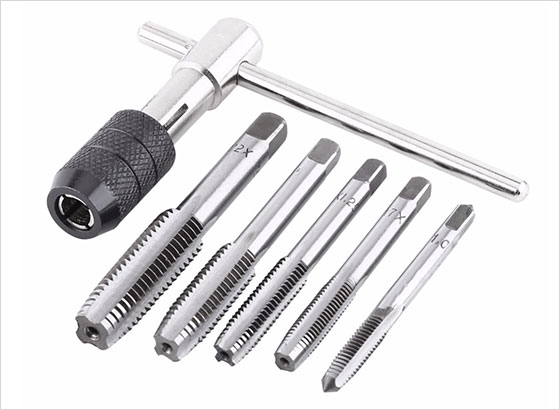Processes
- Polymer Processing
- Injection Molding Insert Molding Blow Molding Over Molding Metal Injection Molding Thermoforming
- Metal Casting
- Die Casting Castings & Forgings Wax Casting Lost Wax Casting Grey Iron Castings Centrifugal Casting Investment Casting Permanent Mold Sand Casting Shell Mold Casting Aluminum Investment Casting Brass Investment Casting Steel Investment Castings Titanium Investment Casting
- Machining
- Milling Turning EDM machining CNC Engraving Hole-making Tap Size Chart Drill Size Chart 5 axis machining Micro Machining CNC Cutting Metal Processes Ceramic Manufacturing Swiss Precision Machining
Materials
What is a Tap Tool?
During the process of machining or manufacturing, holes with female screws are often needed. A commonly used way to fabricate this type of threaded hole is using a drill bit to create a hole with appropriate size and then tap it with a tap. The tap tool allows you to tap holes right in the punch press with unparalleled speed and accuracy. A tap can be used to produce a thread for the firs time or it can be run into an exist tapped hole to repair damaged threads.
Tap Sizes Explained
To determine what sizes of tap drill to use for your screw, a standard tap size chart is required.
- Standard tap sizes can be divided into two different groups: sizes less than 1/4” , and sizes 1/4” and larger. For sizes less than 1’4”, instead of fractional measurements, a numbering system ranging from 0 to 12 is used, 0 is the smallest and 12 is the largest. For sizes greater than 1/4”, fractional measurement system is used based on the actual diameter of the screw. The tap size go from 1/4” to bigger fractions.
- Fractional sizes are described in inches, metric sizes are indicated in millimeters following the letter “M”.
- The larger the diameter corresponding to the screw size number, the higher the screw size.
- In the fractional tap size system, the thread count is used, measured in threads per inch (TPI). Thread size is the number of Threads Per Inch (TPI) which is measured along the length of the tap.
- In the metric tap size system, the thread pitch is used, which measures the distance between threads, written in millimeters. Coarse threads have a larger pitch than fine threads, such as UNC (Unified National Coarse) and UNF (Unified National Fine).

Tap Size Chart & Table – Tap Sizes & Dimensions Chart
The tap size table lists standard size taps, specifying the diameter and thread spacing, for fractional, metric, and screw sizes.
